This past Wednesday afternoon, the Gibbes Museum of Art celebrated its first opening of evening hours with the lecture and workshop of visiting artist, Sonya Clark. Now open until 8 pm each Wednesday, the Gibbes offers exciting events exclusive to these later hours that engage the local community with Charleston’s unique art culture. A newly available bar (a pre-cursor to the Café Gibbes) offers beer and wine for guests to enjoy. This Gibbes “Happy Hour” creates an enticing combination for art enthusiasts… art and wine!
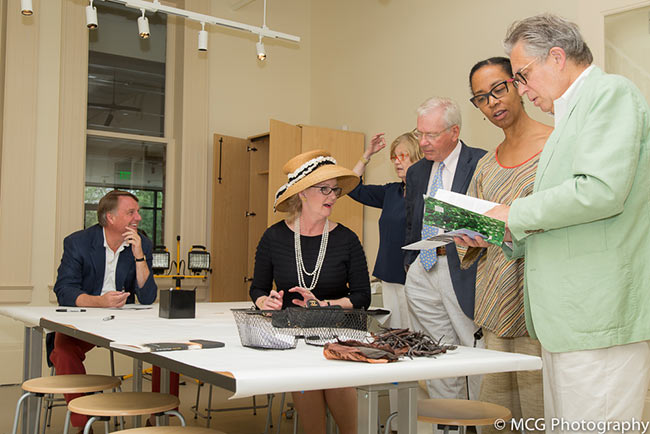
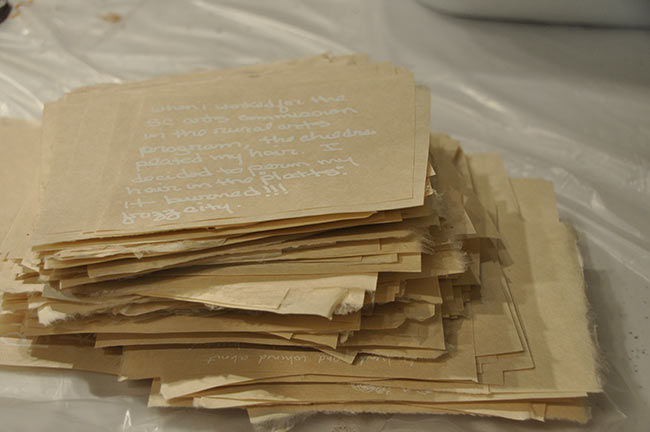
On Wednesday evening, guests perused the first floor with cocktails in hand in anticipation for the lecture and workshop by Sonya Clark. In the Almeida Lecture Hall, Sonya introduced her interactive installation, Pluck and Grow, to the Charleston community. This work of art is a compilation of hair stories from different individuals, transcribed on paper, which Sonya dies in varying shades of black, brown, and blonde to give the appearance of human hair. Sonya proceeds to twist and insert these scraps of paper into holes drilled in a wall. As a finished product the work becomes a large-scale representation of a human head. As I gazed upon her exhibit for the first time, I was struck with the dimensionality of Sonya’s piece. The repetition of inserted “hairs” creates a massive oval that protrudes towards the viewer. While looking at these strands extending towards me, I felt a strong urge to reach out and grab a piece… which is exactly what Sonya desires.
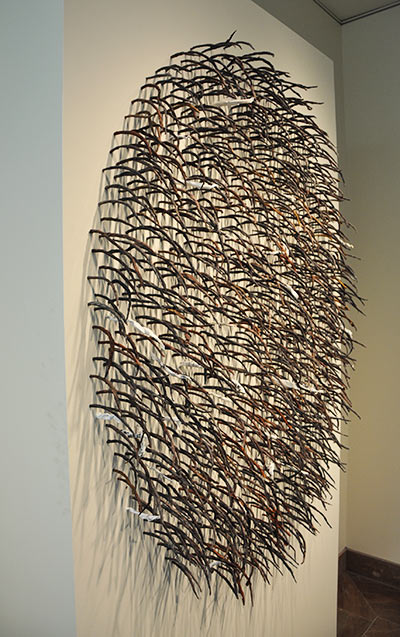
Sonya incorporates a “performative” aspect into her piece, Pluck and Grow, by inviting the audience to pluck a “hair,” read the selected story, and replace the strand with his or her own hair story written on a white sheet of paper. As more colored strands become replaced with white slips, the piece takes on the appearance of aging—akin to real human hair.
Before inviting the Gibbes Museum visitors to participate in Pluck and Grow, Sonya spoke of her inspiration behind hair artwork. As an American artist of Scottish, African, and Jamaican heritage trained in textile arts, Sonya explores her family roots in order to discover her ancestors’ connection with textiles. In a gesture to recognize her Scottish heritage, Sonya wove the McHardy family tartan into an 18-yard long kilt, an item that now never misses a family reunion. Sonya’s Jamaican grandmother, nicknamed “Chummy,” was a skilled tailor. Chummy shared her love of sewing with Sonya at an early age, inviting Sonya to stich and share stories.
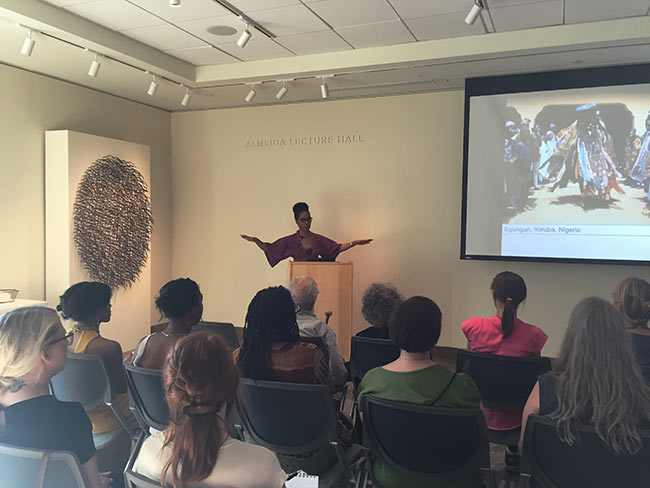
Sonya drew upon these family influences to craft her artistic identity. By using hair as a textile art form, Sonya addresses the different identities that people associate with varying hair and textiles. “Hair, as DNA, is a feature that simultaneously connects and separates us as a human race,” explains Sonya. This interpretation of hair as an equalizer yet also a trait of individuality serves as the foundation of Sonya’s artwork.
As a young child, Sonya enjoyed the pastime of creating different hairstyles with neighborhood friends. “I know what it means to have gravity dependent hair, but I grow gravity defiant hair,” Sonya says with a smirk. As Sonya narrowed her artistic focus in art school, she attempted to recreate the hairdos she wore as a child using crochet thread on cloth. This passion led Sonya to create many pieces of great variety that all share the common denominator of hair. Each work of art questions the identity behind hair and addresses race, culture, and history. Cornrow Chair, 2011, a striped chair with attached cornrows, highlights the contributions of African Americans to the United States through free labor. Through this piece, Sonya gives a voice and recognition to the silent and unnamed people who helped make our city, Charleston, and our country the great community it is today. This thought-provoking piece is currently on display in The Things We Carry exhibit in the Gibbes Museum.
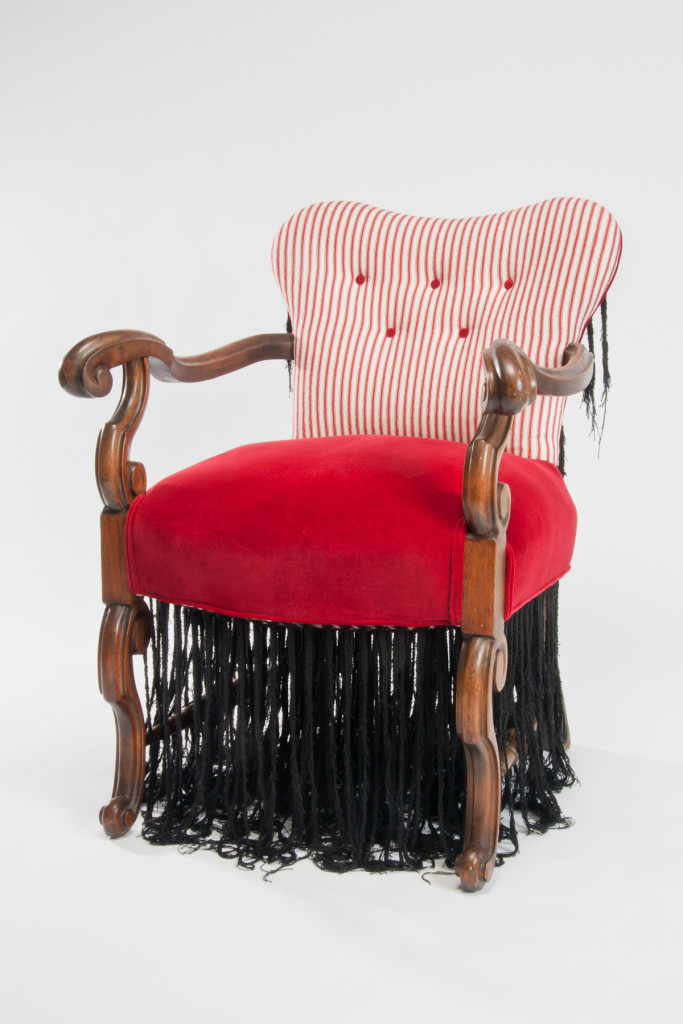
As Sonya led us through her journey as an artist, I was captivated with her diverse portfolio of hair-textile pieces. Each work of art redefined preconceived notions of a particular object or action through a fresh interpretation. Sonya concluded her lecture by welcoming the audience to participate in her interactive installation, Pluck and Grow. Guests and members of the Gibbes Museum crowded around the installation as each person plucked a strand and contributed his or her personal hair story. A group of previous strangers stood laughing and chatting while reading stories or writing a new one. Through the common bond of hair, each person in the audience now stood connected with not only other group members, but also with the previous person who wrote a story. As the only red head in the group, I was eager to share my strange stories of growing up as a “ginger.” I plucked a strand and read my unknown friend’s story… and who could it be? A fellow redhead!
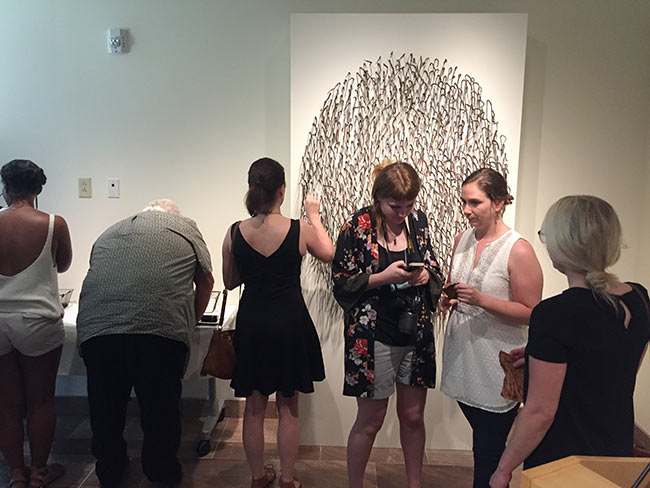
In Pluck and Grow, Sonya creates a work of art that connects strangers through the simple object of hair and thus becomes a collaborative project between the artist and museum visitors. Do not miss this unique opportunity to participate in Pluck and Grow while on exhibit at the Gibbes Museum. Go today to pluck a strand and share your own hair story!
—Helen Clay, Gibbes Museum of Art Intern
Published June 3, 2016

